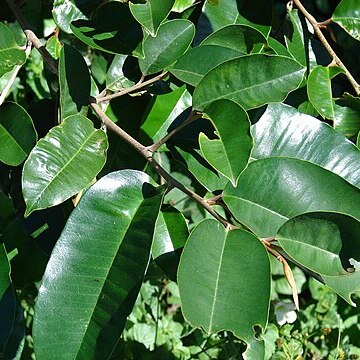Trees. Stems unarmed, densely hairy to glabrate. Leaves persistent, alternate; stipules absent; petiole present; blade: base cuneate to rounded, apex acute to acuminate [rounded or emarginate], surfaces densely hairy [glabrous] abaxially, usually glabrous adaxially. Inflorescences fascicles or solitary flowers. Flowers: sepals 4-5[-6] in 1 whorl, imbricate, abaxially densely hairy; petals (4-)5(-6)[-8], greenish white or greenish yellow, sericeous adaxially, lobes undivided, equaling or shorter than [exceeding] corolla tube; stamens 4-5[-8], distinct; staminodes absent [present]; pistil 3-5(-6)[-12]-carpellate; ovary 3-6[-12]-locular, densely hairy; placentation axile. Berries purple to black [yellow, orange, red, brown, green], ellipsoid to ovoid, glabrous [hairy]. Seeds 1[-5], brown, laterally compressed; hilum narrowly ovate to obovate; embryo vertical; endosperm present. x = [12, 13, 14,] 26.
Shrubs to medium-sized trees. Leaves alternate; blades with the secondary laterals and areoles more or less paralleling the primary laterals. Flouwers several to nu-merous in each axillary cluster, occasionally solitary; sepals (4)5(6), uniseriate, often quincuncial when 5, united at the base; corolla not exceeding 6 mm in length, the lobes (4)5(6), lacking appendages; staminodes absent; staminal fila-ments attached to the top of the corolla-tube or base of the corolla-lobes; ovary appressed-pubescent, 4 to 12-celled, the ovules affixed laterally or basilaterally, the style short (less than 1.75 mm in Panama taxa), columnar, the stigma discoid, marginal lobes often evident. Fruit fleshy; seeds 1-several, the scar large, broadly elliptic to subcordate, at least 5 mm long, lateral or basilateral, the endosperm copious.
Shrubs or trees. Leaves alternate; stipules absent. Flowers small, 2 to many fascicled and axillary, pedicellate or sessile. Sepals 5(or 6), usually glabrous or inside tomentose. Corolla tube campanulate, usually extended, (4-or)5--11-lobed. Stamens (4 or)5--10 in 1 whorl, inserted in throat and opposite corolla lobes; staminodes absent. Ovary 1--10-locular, villous or glabrous. Style longer to shorter than ovary. Fruit 1--8-seeded, exocarp thick to very thin. Seed coat papery to crusty; scar narrow to wide, lateral, sometimes almost covering entire seed.
Flowers usually hermaphrodite (flowers with reduced anthers occur sporadically in some species), 5–merous, borne in few– to many–flowered fascicles in axils of current leaves or on older wood.
Leaves coriaceous or chartaceous, not or sometimes clustered at branch ends; lamina sometimes with lateral nerves very numerous, close, straight and parallel.
Ovary conical, densely pilose, tapering into a short thick style, usually 5–locular; ovules solitary, with lateral or basi–lateral attachment.
Fruit a subglobose to pear–shaped berry, often with lobes corresponding with number of seeds; pericarp fleshy or subcoriaceous.
Seeds (1) 2–S, with long narrow lateral scar; testa hard, smooth and shiny; endosperm copious; cotyledons thin and leafy.
Stamens not exserted; filaments inserted at level of base of lobes or in tube; anthers extrorse.
Corolla cylindric, urceolate or campanulate; lobes entire, equalling or shorter than tube.
Alternipetalous Staminodes usually absent.
Trees or shrubs, sometimes scandent.
Sepals ± free to the base.
Stipules absent.

